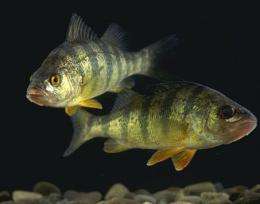July 8, 2011 report
Predatory fish have large guts to help them through famine

(PhysOrg.com) -- A new study by scientists in the US has solved the mystery of why predatory fish have a far greater digestive capacity than they actually need. The study suggests the reason is that the extra-large guts allow them to gorge on food when it is available so they can store the calories for use in the lean times.
It has long been known that in captivity predatory fish can grow much larger than they do in the wild. Their stomachs are usually sac-shaped and capable of processing enormous quantities of food at a time, and in captivity it is easy to over-feed the fish. In the wild the fish must expend a great deal of energy in foraging, stalking, capturing and then digesting their prey.
The unpredictable nature of predation has led some researchers to suggest they can store the energy they derive from gorging on food when it is available to enable them to survive periods when prey is not available, but until now little study had been done on the digestive capabilities of wild animals. This is the first comprehensive study of the digestive capabilities of wild predatory fish.
In the new study, researchers Jonathan B. Armstrong and Daniel E. Schindler of the School of Aquatic and Fishery Sciences at the University of Washington in Seattle analyzed some 639 recordings of 38 species of predatory fish and assessed the load capacity ratios for their digestive systems.
The researchers found the digestive systems of the predatory fish were around two or three times larger than they need to be in average conditions. The large gut allows them to capitalize on “pulses of food abundance,” which requires a high digestive capacity, but maintaining that capacity is costly in energy terms when food is scarce and a large gut is not needed.
Armstrong and Schindler developed numerical simulations of the trade-off that exists between having excess digestive capacity and the metabolic cost of the extra guts. The simulations suggest the trade-off benefits the fish only if they experience irregular periods of feast and famine, and that predator/prey encounters are less common than previously believed.
The paper is published in the journal Nature.
More information: Excess digestive capacity in predators reflects a life of feast and famine, Jonathan B. Armstrong & Daniel E. Schindler, Nature (2011) doi:10.1038/nature10240
Abstract
A central challenge for predators is achieving positive energy balance when prey are spatially and temporally heterogeneous. Ecological heterogeneity produces evolutionary trade-offs in the physiological design of predators; this is because the ability to capitalize on pulses of food abundance requires high capacity for food-processing, yet maintaining such capacity imposes energetic costs that are taxing during periods of food scarcity. Recent advances in physiology show that when variation in foraging opportunities is predictable, animals may adjust energetic trade-offs by rapidly modulating their digestive system to track variation in foraging opportunities. However, it is increasingly recognized that foraging opportunities for animals are unpredictable3, which should favour animals that maintain a capacity for food-processing that exceeds average levels of consumption (loads). Despite this basic principle of quantitative evolutionary design, estimates of digestive load:capacity ratios in wild animals are virtually non-existent. Here we provide an extensive assessment of load:capacity ratios for the digestive systems of predators in the wild, compiling 639 estimates across 38 species of fish. We found that piscine predators typically maintain the physiological capacity to feed at daily rates 2–3 times higher than what they experience on average. A numerical simulation of the trade-off between food-processing capacity and metabolic cost suggests that the observed level of physiological opportunism is profitable only if predator–prey encounters, and thus predator energy budgets, are far more variable in nature than currently assumed.
© 2010 PhysOrg.com

















